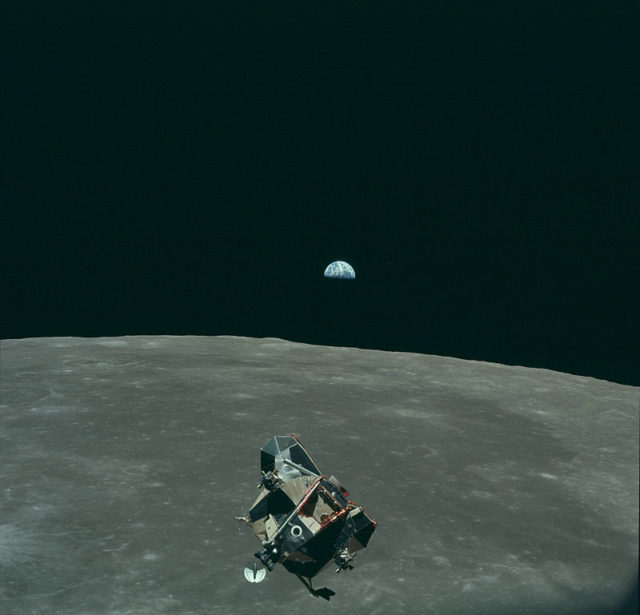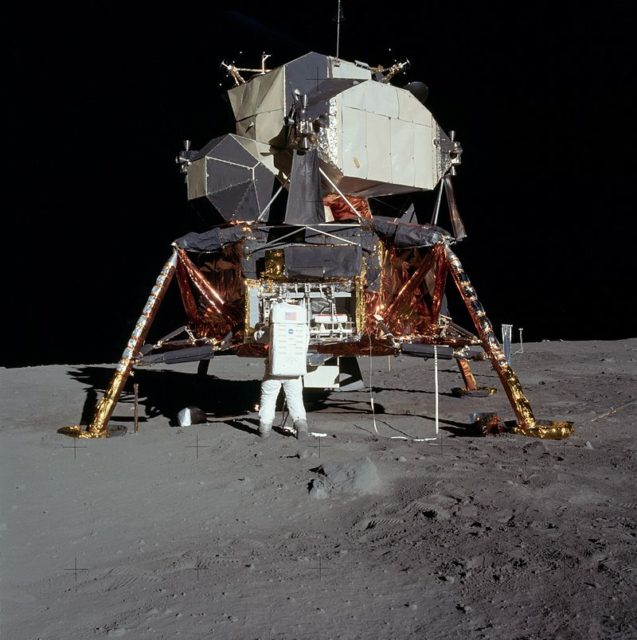There are iconic photographs well known to most of us, and this image, taken by Michael Collins, is especially significant. It shows the lunar module Eagle, with Neil Armstrong and Buzz Aldrin on board and the Earth in the background.
What is so unusual about this photograph is that Michael Collins is the only inhabitant of planet Earth, dead or alive or still to be born, that does not appear in it.
Bear with us here.
The Law of Conservation of Mass states that matter cannot be created or destroyed in a closed system such as Earth’s, it can only change from one form to another. This means that human beings are created from matter, and we maintain it in one form or another. If you were alive when the photograph was taken, then your matter was on Earth. The matter of those who were dead when the photograph was taken would still be on Earth, although in a changed form. And if you were not yet born at the time this photograph was taken, you would be created from the matter on Earth, so the matter that would eventually become you is on Earth and therefore in the photograph.

Apollo 11 was the space mission that fulfilled the promise made by President John F. Kennedy in 1961 when he said that the United States would send a manned mission to the Moon and return to Earth. This mission was carried out by three men: Commander Neil Armstrong, who was aged 38 at the time, Colonel Edwin Eugene “Buzz” Aldrin, who was 39, and the command module pilot Lieutenant Colonel Michael Collins, who was also 38.
They took off from the Kennedy Space Center at 9:30 AM on July 16, 1969, and they arrived in lunar orbit on July 20, 1969. Late in the afternoon the lunar lander Eagle separated from the command module Columbia and headed for the lunar surface. Eagle touched down in the Sea of Tranquility at 4:17 PM, and Armstrong uttered the first of his two iconic phrases: “Houston this is Tranquility Base. The Eagle has landed.”
The two men in the lunar module, Armstrong and Aldrin, spent the next few hours performing mission tests before suiting up to walk on the moon. At 11:56 PM Armstrong stepped onto the lunar surface and uttered the second of his iconic phrases: “That’s one small step for man, one giant leap for mankind.” Buzz Aldrin stepped onto the surface some 20 minutes later.
The two astronauts spent some 21.5 hours on the surface of the Moon, with their walk lasting a little over 2.5 hours. In that time, they conducted experiments, collected samples of moon rock, and traversed less than a mile in all. They also erected the American flag and chatted with the president of the United States, Richard Nixon.
While Aldrin and Armstrong were on the surface of the Moon, Collins was on his own in the command module. In a 2009 interview for The Guardian, Collins described the loneliness and fear he experienced while waiting for his crewmates to return. As this was the first manned mission to the Moon, no one could be 100 percent sure that the Eagle would blast off successfully. The astronauts were not entirely sure that the engine of the Eagle would reignite on the surface or that it would burn for the seven minutes needed to get the craft off the moon and back into an orbit that would allow it to dock once again with Columbia.
All through the day Collins was on his own and plagued with fears that he would have to return to the Earth alone. In a note written at the time, Collins said, “My secret terror for the last six months has been leaving them on the Moon and returning to Earth alone; now I am within minutes of finding out the truth of the matter. If they fail to rise from the surface or crash back into it, I am not going to commit suicide; I am coming home, forthwith, but I will be a marked man for life, and I know it.”
Not only did Collins fear for the safety of his two companions, but he was all on his own while the Columbia orbited the Moon. When it traversed the dark side of the Moon, he was truly alone in space, as even his communication with Houston was cut off. This incredibly brave man sat alone in the Columbia and wrote, “This venture has been structured for three men, and I consider my third to be as necessary as either of the other two. I don’t mean to deny a feeling of solitude. It is there, reinforced by the fact that radio contact with the Earth abruptly cuts off at the instant I disappear behind the moon, I am alone now, truly alone, and absolutely isolated from any known life. I am it. If a count were taken, the score would be three billion plus two over on the other side of the moon, and one plus God knows what on this side.”

It is likely that walking on the moon will continue to fire the imagination of men and women all over the globe.
Read another story from us: NASA has released over 10.000 photos from the Apollo moon mission
Perhaps when man sets foot on Mars, our fascination will wane, but until that time we can only wonder at how brave these men were, who set off for space with no certainty that they would return.
